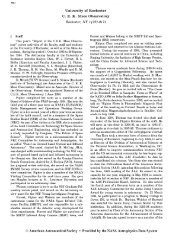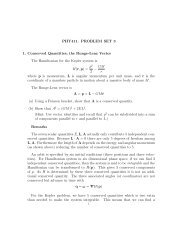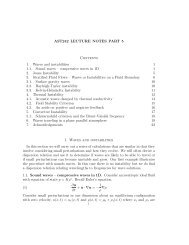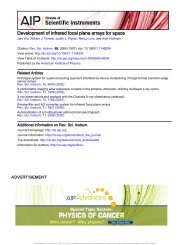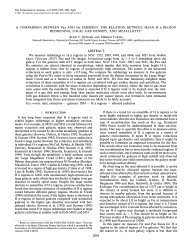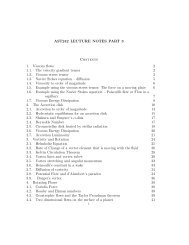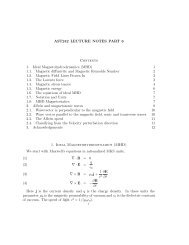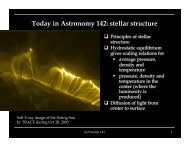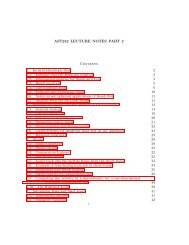Lab 1 â Measurements of Frequency - Astro Pas Rochester
Lab 1 â Measurements of Frequency - Astro Pas Rochester
Lab 1 â Measurements of Frequency - Astro Pas Rochester
Create successful ePaper yourself
Turn your PDF publications into a flip-book with our unique Google optimized e-Paper software.
Physics <strong>of</strong> Music PHY103 <strong>Lab</strong> Manual<br />
2. If you measured the frequency with both oscilloscope and counter, which method did you find<br />
most accurate? How could you tell it was the most accurate? Can the counter measure fractional<br />
frequencies? Is it more accurate at low or high frequencies?<br />
3. About how accurately can you measure the frequency with the oscilloscope and counter? (to what<br />
% or what difference in Hz?). Is the accuracy <strong>of</strong> your measurements higher or lower at low<br />
frequencies than high frequencies?<br />
4. Discuss trends or lack <strong>of</strong> them. You may find it easier to illustrate trends by making a figure<br />
plotting the measurements from each instrument or by referring to lists <strong>of</strong> numbers in a data table.<br />
5. Is the difference between the frequency you measure on your body and 60Hz from AC power<br />
within your estimated errors? If the difference is less than the error then your measurement is<br />
consistent with 60Hz and so the frequency you measure on your body is likely to be ``consistent<br />
with’’ 60Hz. If the difference is greater than your estimated error then it is possible you are<br />
measuring something else (and so would be ``inconsistent with’’ 60Hz).<br />
6. Is it possible to use the counter to measure the frequency you picked up on the oscilloscope probe?<br />
(We used the oscilloscope to look at this signal but found that the counters were pretty accurate ---<br />
so why didn’t we use the counter to measure that frequency?)<br />
MINIMAL REQUIREMENTS FOR THIS LAB REPORT<br />
• Your name, lab group and collaborators.<br />
• A clear abstract at the top stating what your major findings are. For this report you should<br />
have an opinion about which types <strong>of</strong> measurements for frequency are most accurate.<br />
• A clearly labeled data table showing your measurements <strong>of</strong> frequencies that is used to support<br />
your findings.<br />
• Additional discussion based on the questions above.<br />
A good lab report would in its body provide evidence that clearly supports the findings summarized in<br />
the abstract. For this lab, a good lab report would have a clear description <strong>of</strong> how errors in measurements<br />
are estimated. It is likely that the most accurate measurements are those with the smallest errors. A good<br />
lab report would in words have discussion comparing columns <strong>of</strong> data in the table. A good lab report<br />
would compare the difference between the frequency you measure with the oscilloscope probe and 60 Hz<br />
with an error estimated for frequency measurements. This difference would then be used to argue that you<br />
did or did not measure 60Hz. If you measured something consistent with 60 Hz (by consistent we mean<br />
near or within your estimated error) then it is likely the signal was associated with AC power.<br />
Note: A good lab report clearly presents data and discussion that are used to support the summarized results<br />
in the abstract --- even if these results are surprising. Contradictory data should be mentioned and<br />
discussed rather than hidden. There is no shame is reporting contradictory or surprising experiments. If<br />
you suspect your measurements are spurious then you can add discussion speculating about what might<br />
have gone wrong in your experiment. It should be possible to get full credit on a lab report even if your<br />
experiment fails. *<br />
*<br />
Electric power in the United States is in the form <strong>of</strong> alternating current (AC). The voltage on an<br />
electric outlet looks like a sine wave (is alternating) with a frequency <strong>of</strong> 60Hz. The amplitude <strong>of</strong> the<br />
voltage oscillation is approximately 110 Volts. The standard for most <strong>of</strong> North, Central, and South<br />
America and the Caribbean is 60Hz and 120V AC. The standard for much <strong>of</strong> the rest <strong>of</strong> the world is<br />
50Hz and 220V AC. Your body, because it is full <strong>of</strong> electrolytes, conducts electricity and can act as<br />
an antenna. The ground level seen by the oscilloscope may differ from the voltage <strong>of</strong> your body. If<br />
you touch one hand to the tip <strong>of</strong> the probe and the other hand to the ground <strong>of</strong> the probe you will still<br />
see the 60 Hz signal but it will be weaker. 60 Hz noise is <strong>of</strong>ten a problem in electronic equipment.<br />
You may have heard an undesirable “60 Hz Hum” on a speaker system or electric guitar and we might<br />
pick it up when recording sounds later in the term (hence bringing this to your attention now). There<br />
are a variety <strong>of</strong> ways to get rid <strong>of</strong> 60 Hz noise, including the use <strong>of</strong> shielded (such as BNC) or twisted<br />
cables, humbucker pickups and well grounded instrument housings.




